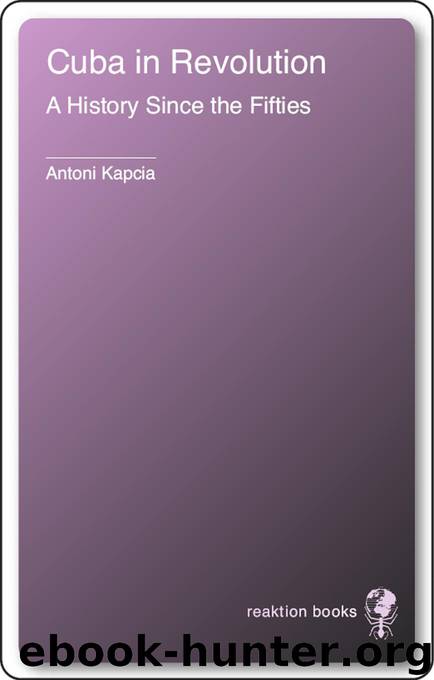Cuba in Revolution: A History Since the Fifties (Contemporary Worlds) by Kapcia Antoni

Author:Kapcia, Antoni [Kapcia, Antoni]
Language: eng
Format: mobi
Publisher: Reaktion Books
Published: 2012-10-02T16:00:00+00:00
Chapter 5
Spreading the Revolution: The Evolution of an External Profile
Since the Revolution was always as much about achieving and defending real independence as about social change, its external projection was always integral to the whole process of transformation. Most obviously, this meant, firstly, challenging, changing or ending the fifty-year-old dependent relationship with the United States and then addressing the US-enforced isolation and hostility; it then acquired another dimension, the new relationship with the Soviet Union, often described as a ‘satellite’ or dependant relationship. The question of the Revolution’s external dimension also goes beyond this, however, for the changes after 1959 also meant changes to the ways in which Cubans sought a new role, status and meaning for Cuba in the world. Having historically been a pawn in larger global battles (1762, 1898 and 1962), Cuba’s new redefinition in the world was therefore an integral part of the revolutionary project, and hence of its ideological development. Therefore ‘foreign policy’ in revolutionary Cuba has always meant more than just the normal processes of relating commercially or diplomatically to other governments or signing treaties: sometimes it has reflected and contributed to the debates, formulations and character of domestic politics, but at other times it has reflected relations with the two superpowers between which Cuba had to operate until 1991. Given the importance of this external dimension, those who have made and executed Cuban foreign policy have often been key players. Certainly, Fidel Castro himself has long played a more decisive role than one might normally expect, his personal relationships with foreign leaders often determining overall policy towards that country, most notably regarding Nicaragua, Grenada, India and, most recently, Venezuela. However, others have also been crucial, notably Guevara, Raúl Roa (the first Foreign Minister, who most helped redefine Cuba as a Third World nation) and Raúl Castro (as head of the FAR).
Inevitably, the starting point for all this must be the rapid unravelling of US–Cuban relations in 1959–61, and then the continuing role played in Cuban politics by US policy towards Cuba and by Cuban attitudes towards Washington. As we have seen, the ending of a once close relationship was a crisis waiting to happen, developing a momentum of its own in the face of misunderstanding by the United States and resentment from Cuba, both reactions rooted deeply in the two political mindsets and both having long-term implications. While the rebel movement displayed no visible anti-Americanism before 1958, there were already signs of potential conflict in the post-1953 radicalization, as the guerrilla vanguard began to recall old suspicions of the US role in Cuba (echoing the earlier anti-Plattism) and, influenced by Guevara, feel their way towards a tentative anti-imperialism. Guevara brought (from his Guatemalan experience) a wider awareness of the inevitability of conflict with what he saw as US imperialism, which few of his Cuban comrades shared. As we have seen, the United States as ‘problem’ had largely disappeared from the Cuban political discourse after the US abrogation of the Platt Amendment in 1934, and the PSP largely followed Moscow’s line of peaceful coexistence after 1946.
Download
This site does not store any files on its server. We only index and link to content provided by other sites. Please contact the content providers to delete copyright contents if any and email us, we'll remove relevant links or contents immediately.
| Antigua | Bahamas |
| Barbados | Cuba |
| Dominica | Dominican Republic |
| Grenada | Haiti |
| Jamaica | Saint Kitts |
| Saint Lucia | Saint Vincent |
| Trinidad and Tobago |
Cat's cradle by Kurt Vonnegut(15262)
Pimp by Iceberg Slim(14438)
4 3 2 1: A Novel by Paul Auster(12333)
Underground: A Human History of the Worlds Beneath Our Feet by Will Hunt(12054)
The Radium Girls by Kate Moore(11977)
Wiseguy by Nicholas Pileggi(5711)
The Fire Next Time by James Baldwin(5386)
Perfect Rhythm by Jae(5359)
American History Stories, Volume III (Yesterday's Classics) by Pratt Mara L(5276)
Paper Towns by Green John(5141)
Pale Blue Dot by Carl Sagan(4960)
A Higher Loyalty: Truth, Lies, and Leadership by James Comey(4909)
The Mayflower and the Pilgrims' New World by Nathaniel Philbrick(4463)
The Doomsday Machine by Daniel Ellsberg(4452)
Killers of the Flower Moon: The Osage Murders and the Birth of the FBI by David Grann(4410)
The Sympathizer by Viet Thanh Nguyen(4344)
Too Much and Not the Mood by Durga Chew-Bose(4305)
The Borden Murders by Sarah Miller(4278)
Sticky Fingers by Joe Hagan(4148)
